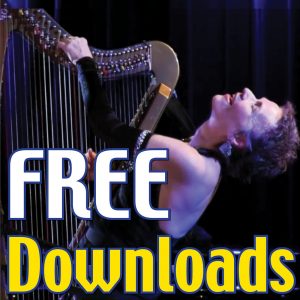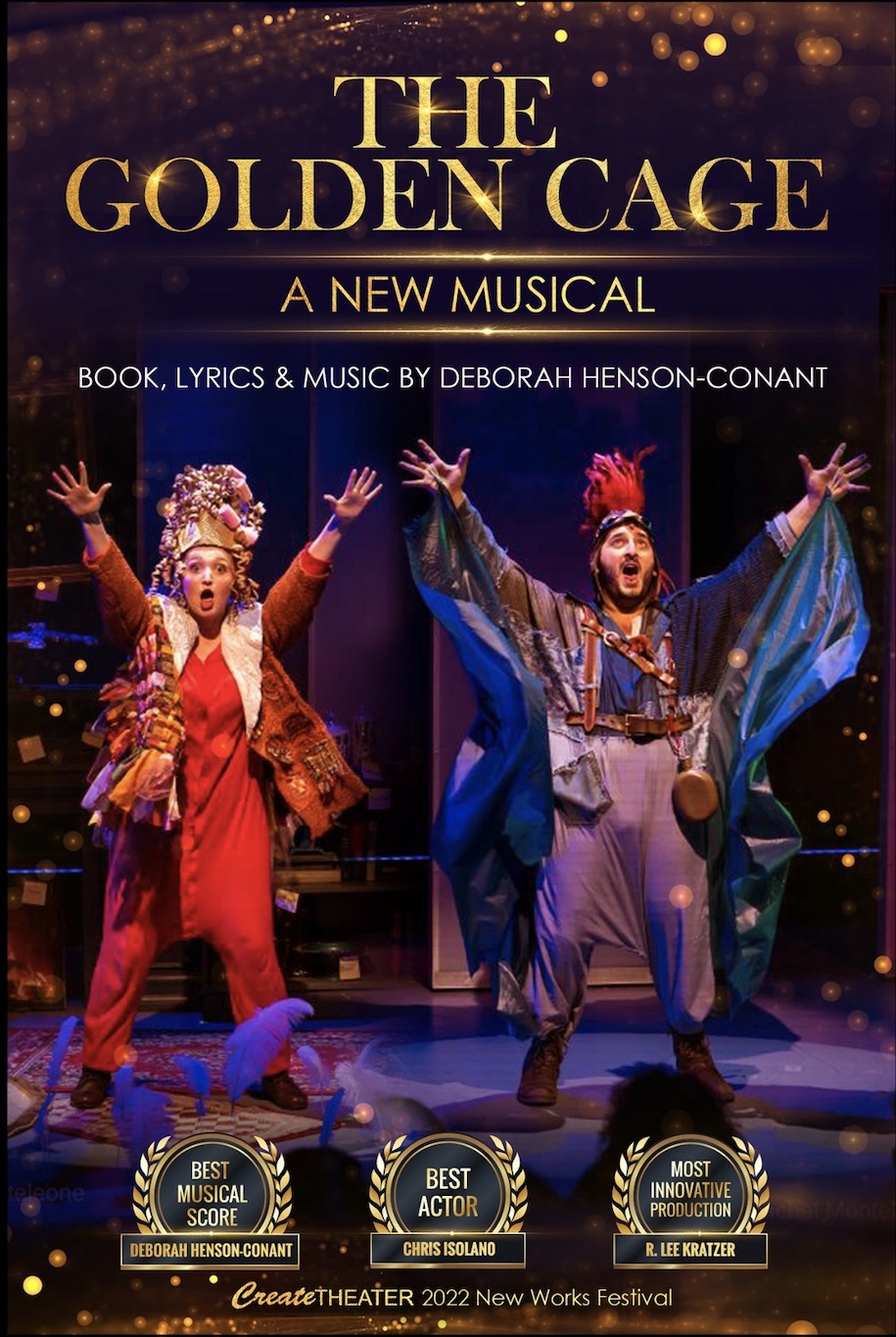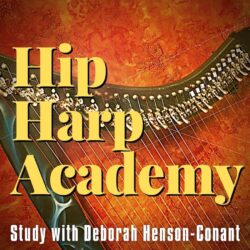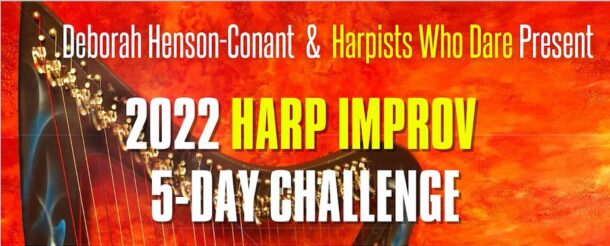
When 14 Harps Played 12-Bar Blues
Or, how the Salmon of Knowledge hooked Dave Brubeck in Scotland
In 1988, I was invited to the Edinburgh Harp Festival. There were 14 harps playing 12-Bar Blues – now there are hundreds in our yearly Blues Jam Harp Challenge each year. Many of them go on to join us in Hip Harp Academy, where they develop their improv and self-expression and creativity ….
WHEN BARBARA McDERMIT invited me to Edinburgh to teach and perform jazz at the Seventh International Harp Festival, I had no idea what I was getting into. I knew the Scottish people had a history of playing music together but when I was told I would be teaching classes of 10 to 14 people playing harps, it just didn’t sink in. Had I ever seen more than three or four harps together in a single room? Could I imagine that many harps playing jazz? Nevertheless, I boarded the plane full of grave expectations.
The direct flight from Boston to Glasgow, on the route to Edinburgh, is not much longer than from Boston to California, and I slept the whole way. I woke with a feeling of having traveled not through the air but through a dream-and looked down on Scotland.
The land is sweet and green, with a vague sense of magic that is fleeting but unmistakable. The fact that everyone was driving on the “wrong” side of the road only added to my sense that I had stepped beyond the looking glass into this softly lilting land.

This is the Carnethy Cottage where I stayed.
When I arrived at Carnethy Cottage in the small hamlet of Silverburn where I was to stay, I was greeted by my soft-spoken host, Jack, harp-builder whose wife, Barbara had arranged my visit. There was someone else who wanted to meet me immediately, Jack said as he led me into their cozy little living room.
There, opposite a centenarian harp, carved and gilded, sat a simple splendid instrument of natural wood, still glistening from the final rubdown Jack had given it. Carved into the creamy maple of the the column were a leaping fish and a dragonfly in flight. “This is the Salmon of Knowledge,” Jack said. “He’s just been finished to go with you while you are here.”
So my hands would be the first hands to touch the music on its strings, I thought. I had never played so new an instrument and expected it to be uneven and uncoordinated. But the subtle strength of its vibrations moved throughout me as I played. This was the first real “clarsach” I had ever known.

Me in concert a few years later, playing one of Jack’s harps
The clarsach is the traditional Scottish harp. Smaller than the concert harps I am used to playing, clarsachs are also completely different mechanically. On my large harp, I change keys with 7 foot pedals.
Each pedal corresponds to a “family” of strings, so there’s one pedal for each family of the musical alphabet, A through G.
Clarsachs have no pedals or rods, but a single hand-operated lever on each string which allows that string’s pitch to be changed individually.
Interestingly, this difference opens up a new world in the Blues – because you can tune different parts of the harp in different keys.
It was fascinating, I thought-but can you play jazz on it? In one way, the whole point of jazz for me is the movement from one key area to another. I gulped as I remembered that one of my personal playing characteristics is how much “pedaling” I do, how often I change keys and use the pedals for jazz effects. Well, maybe the students in the classes will have concert harps, I thought, and I can always bring that centenarian in the corner out of retirement for a couple of weeks.
But I was not in luck. After a week of traveling to television and radio interviews all over Scotland publicizing my upcoming performances, I walked in’to the classroom early Saturday morning and was greeted by 14 grinning harpers with an eclectic stable of harps-and nary a pedal on any of them. There were metal-strung Celtic harps, leverless Irish harps, quite a few locally built clarsachs, and even a backwards-strung Paraguayan harp (where all the F’s looked like C’s and the tuning key had to turn counterclockwise on the wrong side of the harp). This did not bode well, I thought. And I was soon to meet head on with my challenges.
Tuning a single harp is no mean task, and it is often said (with regrettable accuracy) that “harpists spend half the time tuning and the other half playing out of tune.” I soon discovered that listening to 14 harps tune at once could be used to extract confessions from the most hardened criminal. The worst part, of course, is that the instruments aren’t a great deal more in tune after the ordeal than before. But it’s an appealing sort of dissonance, I tell myself – “quaint.”
Communication was the next hurdle. Within the class there were students from all over Europe, many with only the slimmest working knowledge of English. So in-depth discussions of jazz techniques were out. We would simply have to play and do our communicating musically.
After a week alone with the Salmon of Knowledge, I had discovered that, even with a minimum of “levering,” a boogie-woogie bass line was not impossible. So we started with that, the basis of blues, and I was surprised at how quickly the students, some as young as 10 and some in their early 60s, picked it up.
Jazz rhythms are not always simple! and even the gentle feel of the “swing” rhythm is not one that most classical musicians fall into easily. But the Scottish players come from a tradition of “triple meter” dance tunes, which I began to suspect might have influenced jazz in some way.

The room I was teaching in looked something like this.
The group’s ability to “swing” en masse was astounding, and soon the class had split into the four camps that make up a jazz quartet. Some of them were playing the boogie-woogie blues bass line, others were “comping” with short rhythmic chords, a small group was acting as the percussion section by tapping bongo-like on the soundboards of the harps, and the final group was “stepping out” to take saxophone-type jazz solos. Hands were flying up to the levers as the bass-liners added the “7ths” that are a staple of jazz harmony, and the soloists flicked levers to create “blues notes” and “slides” in their improvised melodies.
By the third day they seemed to have mastered the 12-bar blues, had begun working out solos and fairly complex arrangements-and were ready for more. Fine, I thought, we’ll learn a jazz waltz, that’s pretty simple. And simple it was-too simple for them. By the fourth day they had split into smaller groups to create and perform their own arrangements, and when the German-Scottish contingent returned, the. waltz was not a waltz anymore. It was sounding suspiciously like “Take Five,” whose title comes from its rhythm in five-four time, not the three-four of the waltz. In fact, it was ”Take Five,” at least for the first four bars, and this melodic transformation was lost on no one. As soon as they heard the “vamp” the whole group was clamoring to learn the melody of Dave Brubeck’s jazz classic.
I was about to say “but that’s not playable on the clarsach” when the Salmon of Knowledge gave a little shiver. ”Well, give me a minute,” I grumbled, and within five minutes I had realized that, with a great deal of lever-flipping, it not only was playable but sounded wonderful. That was all it took, and from then on “Take Five” floated from the practice rooms for hours. But they didn’t just play-they sang! So naturally and sweetly, as though it was the most natural thing to do when playing a melody on the harp-as indeed it is in Scotland.
By the end of the week I realized I was one lucky listener-the first in the world ever to hear 14 harps playing 12-bar blues, 10 harps playing “Take Five,” and clarsachs swinging in a jazz chorus. I proudly listened as the groups performed in a final “ceilidh” (pronounced “kaylee”), or musical party, and I left with the sense that I had been part of a merging of the musical traditions of this beautiful magic land and my own.
Coming back through the looking glass to America, I feel the sense of dreaminess has not left, and I now find myself sneaking little Scottish melodies into my jazz sets … and hearing a faint echo of 500 strings in sympathetic vibration when I do it.
By the way, they did bring me a brand new “chromatic” or “pedal” harp for my concerts.
Trucked up from London by its builder, the “Pilgrim” pedal harp, only five feet high, provided my feet something more to do than simply tap wildly to the rhythms of the chorus. In concert I was mechanized again! And was the Salmon of Knowledge jealous? No, it knew it had stolen my heart, and Jack has just written to say it eagerly awaits my return next year.
Harpists Who Dare!
Are you ready to free yourself from the notes on the page?

PROJECTS & PERFORMANCES:
FOR HARPISTS:
- Join Hip Harp Academy
- Harp Time Live (FREE Weekly Playalong)
- FREE Resources






I love reading and hearing about your fantastic experiences! Did you ever learn the meaning Jack attributed to the name “Salmon of Knowledge” he gave to that clarsach?
I’m so glad you enjoyed the story, Joyce! The Salmon of Knowledge is a famous character in Irish mythology https://en.wikipedia.org/wiki/Salmon_of_Knowledge
I was in two of your Edinburgh Harp Festival classes around that same period and my little sister and I took some private lessons. Your energy and creativity inspired me so much and led me to continue exploring jazz/improvising throughout my years studying and beyond! I’ve used some of your materials from those Edinburgh classes for teaching my own students and I enjoyed reading about how this time was a new pathway for you too!! My music took me across the globe to Asia and now to NYC – recently auditioned for the Rockettes orchestra. I never would have thought as a wee kid in Edinburgh that music could come in so many shapes/forms or take me so many places and I think you were a huge part of opening my eyes and making me hungry for new experiences! So thank you!
I remember you and your little sister! The two of you took a private lesson with Park Stickney and me, yes? I’m so honored and delighted to think of being a part of this wonderful life you lead as a harpist – I was just enjoying your website ( https://harpnyc.com/ ) and I love that you’re still using some of those materials from Edinburgh with your own students. I don’t know if I even still have them myself. Thanks so much for your comment and congratulations on bringing so much music into the world with those fingers and voice connected to your wonderful spirit. I especially loved the photo on your site of you with a group of little kids.